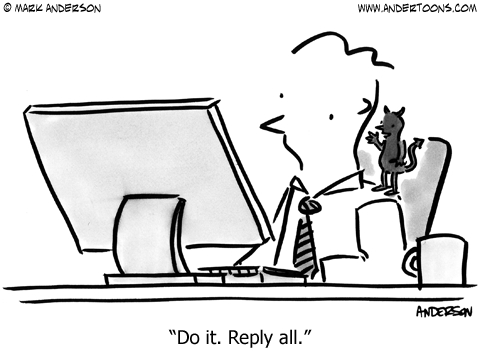
As I said before, there are so-called ‘coaches‘ for almost everything. But I still didn’t find anyone offering him/herself as an ’email writing coach’. So, let me share with you some obvious but useful tips to write an email, a tool that is as daily as dangerous.
I found it well described in this post of Bruce Mayhew (who is in fact promoting his training on email writing, but then it’s up to you to decide whether you need that), so I wouldn’t reinvent the wheel but just summarize it:
- Say Hello, Good Morning or Good Afternoon. Disregard this if you send the same person 20 or more emails each day.
- Get to the point. After saying Hello or Good morning, your first sentence should be your key point or action item. Once you’ve explained that, you can then provide the background information.
- Always reply to email, especially if someone is waiting for the information you have. It’s polite, time efficient and builds relationships when you reply.
- Be careful with Reply All. If there are people listed in the Cc: field, pause. If they need to know, make sure you use Reply All. If they don’t need to know then Reply to only those people who do.
- If you’ve been asked two questions be sure you provide two answers. If you need more time for one of the questions, provide the answer to one and let them know how much time you need for answer two.
- Format your email. Use paragraphs and bullets extensively.
- Attract your readers attention using your email subject line. If your email subject line is one or two words it’s likely not going to get them interested. “Sales Meeting” is poor, while “Friday’s Sales Meeting: Location Change” is much better.
- Identify Attachments. It ensures people don’t miss the attachment (which happens often). When sending attachments try to name the files something appropriate. File0001 & File0002 mean nothing vs. Q12014Sales & Q22014Sales let your reader go directly to the attachment they want to see first.
- It’s often easier to phone. It’s difficult to describe detailed situations by email. It’s impossible to brainstorm. If you have a complicated message, discuss in person or by phone and then summarize your conversation in a simple email message to make sure everyone agrees. IF you have bad news, a face-to-face conversation or phone call is a far better solution even though you might feel a bit uncomfortable.
- Walk away if you feel frustrated or angered by an email you received or some other influence, don’t write an email and don’t click Send to anyone. Go for a walk, take lunch, write out your frustration on a pad of paper, do a three-minute breathing meditation, do anything but don’t click send. Whatever you write will likely have a disagreeable tone to it… which is never good.
- If your email ‘chain’ is getting long, it’s very efficient to take a moment to summarize. What has been decided? What is still outstanding? Can some people be removed from the email chain? If you don’t summarize long email it is easy to miss important items.
And his best tip: “Never write an email you would not want on the front page of a newspaper. If you wouldn’t be proud to send the email to your mother — re-write it.”
Do you want to test your email writing abilities? Just write a short email to info at orientaeuro.eu telling us about your current and desired usage of your talents and passions at work (we love to read about it, don’t worry for our time). We promise to give you feedback!
